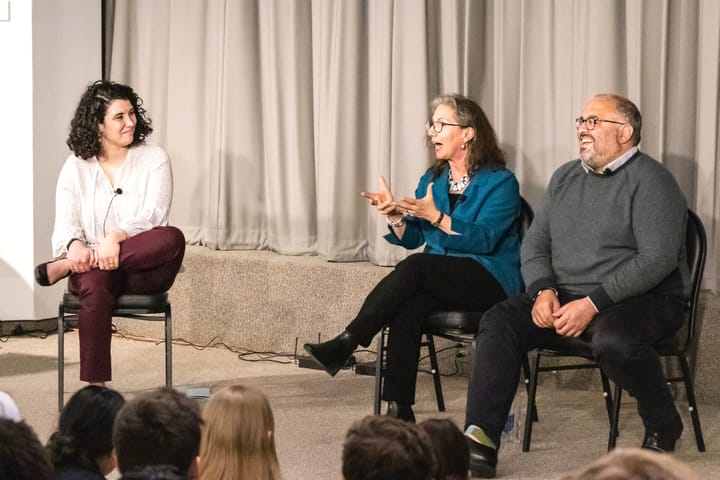Changes in Dining Hall Options Bring Challenges for Students
In an effort to deter Covid-19 at the start of Spring 2020, Valentine Dining Hall (Val) transitioned from self-serve, buffet style to to-go meals, which has presented immense challenges for students with dietary restrictions and student athletes.
In an effort to deter Covid-19 at the start of Spring 2020, Valentine Dining Hall (Val) transitioned from self-serve, buffet style to to-go meals, which has presented immense challenges for students with dietary restrictions and student athletes. Despite Val staff’s best intentions, a decreased selection, unreliable menus and protein rationing have made food an unnecessary stressor for students.
Throughout the pandemic, Dining Services has made a concerted effort to make the student dining experience as positive as possible. Director of Dining Services Joe Flueckiger said, “Over the past 18 months we have adapted to a series of changing priorities based on the safety of our community. These changes have been difficult for all of us. The adaptations, additional labor needed, increased packaging and reduction of menu items are challenges we are doing our best to manage.” Flueckiger noted that he thought that the campus dining experience during the Spring 2021 semester was a favorable one for most students on campus.
Flueckiger is regularly in contact with dining directors from Williams, Connecticut College, RISD, Wellesley, Tufts, Harvard, Middlebury, Smith, Mount Holyoke and Bowdoin to discuss present challenges and methods of improvement.
One reigning difference between Amherst and the aforementioned institutions is the cost of the college’s meal plan. For the Fall 2021 semester, the only meal plan offered is $3,700. In the past, this bought students 26 meals per week: daily breakfast, lunch and dinner and late-night dining five days per week. Due to staffing difficulties and disruptions in the supply chain disruptions, traditional late-night options are no longer offered. The college has begun offering a late night food truck and pizza option on Thursdays as a temporary substitution to late-night dining.
When breaks are not taken into account, students pay an average of $33 dollars per day for on-campus dining. The hefty cost of dining at Amherst is nearly double that of the national average for undergraduates. According to the Department of Education, four-year private institutions charge about $2,800 on average — approximately $25 per day. The average daily cost when public institutions are taken into consideration, is $18.75 day for a three-meal-a-day contract.
At Williams, students have the opportunity to choose the meal plan that best fits their needs. They can choose to designate anywhere from $902 to $3687 per semester on on-campus dining. Tufts students can select meal plans that cost anywhere from $640 to $3689 per semester.
At Val, students are offered a standardized rotating menu of two hot entrees and sides, as well as salad and snacks. The “Allergen Friendly” side and “Traditional” menu are listed before meals on the dining hall website.
The comparably hefty price tag has not been the only cost of eating at Val during the pandemic semesters several students report. At the beginning of Covid, the food selection offered by Val significantly decreased. Notably, staples such as gluten free pasta, plant-based milks, gluten-free breads and snacks, oatmeal and dairy-free cheese disappeared altogether. These foods have recently made a reappearance in the dining hall. Additionally, stations like stir fry, pasta, panini presses, waffle makers and the soft serve ice cream station were also taken away when the pandemic began. Only the panini press has been brought back in the Fall 2021 semester.
Protein was also rationed briefly during the fall 2020 and spring 2020 semester — students were only allowed one chicken breast or piece of fish per meal. The policy has been repealed this semester.
The changes introduced at Covid’s start were disappointing for many students who had enjoyed Val in its original form. William Snead ’23, a member of the cross country team said, “My freshman year [Fall 2019] I was pleasantly surprised by Val. I know it receives some slander, but overall I thought it generally covered all the options and tried to offer a couple of choices at every meal.”
Those with dietary restrictions were also pleasantly surprised by the numerous options offered at pre-Covid Val. Grace Geeganage ’23, who has a gluten and dairy allergy, stated, “I was very impressed with the variety of foods offered at Val when I first visited campus, particularly the 'Allergy Haven' section and the Lighter Side options.” Geeganage expressed that she had no troubles finding food for every meal her first year.
In spite of the dining staff’s best intentions, and concerted efforts to bring back the selection it once had, Val’s transformation has negatively impacted the student dining experience. For many athletes — who have sizable caloric needs — and those with dietary restrictions, the decrease in food supply had detrimental effects. Snead said, “Last fall, I experienced extreme weight loss and complications related to [food rationing and decreased options at Val]. I was unable to continue training for my sport due to Val’s rationing of food and the tiny window of time it was open, especially at the beginning of the year.”
He continued, “My experience in Fall 2020 was positively awful in regards to Val. Starting out by having limits on the amount of food you were allowed to have when it was literally the only option for us under the incredibly harsh Covid restrictions was brutal. In addition to just being a logistical nightmare, I think the take-out only operation Val [was previously running on] can be unnecessarily taxing on our psyche.”
“Eating out of a little green box that you have to carry outside with a million salt, hot sauce [and] mustard packets can kind of weigh on you when you do that for every meal,” Snead admitted.
Geeganage ultimately decided not to return to campus in Fall 2020 because the dining hall was unable to support her needs. “As soon as we found out we were being sent home, Val started limiting the variety of foods served, which also limited my ability to find things to eat. In Fall 2020, I decided not to come to campus because Val was not going to have what I needed and I wouldn’t have been able to leave campus to go to Target or get takeout instead.”
In the spring, Geeganage was on campus — getting adequate nutrition was still an undue burden. “Food was a constant stressor because there were days when I couldn’t eat the meals served. I ended up making my own food a few times a week because the Val meals didn’t fit my dietary restrictions,” she said.
Students and athletes who have nutritional concerns are encouraged to contact Student Accessibility Services to determine appropriate accommodations. Those who do reach out used to be directed to the school’s nutritionist. The school’s nutritionist left the college in the summer, and the position is presently unfilled. For the time being, students are directed to the ACNutrition online software.
Though Dining Services is doing its best to “satisfy and delight students with healthy, amazing food prepared with care,” in the words of Flueckiger, students note that there is still room for improvement.
“I think offering more options than just traditional or allergen friendly (such as a pasta or pizza bar) would be great,” Snead said.
Geeganage also noted that the biggest alteration she would like to see is that the posted menu matches what is actually in Val. Geeganage expressed that she “would appreciate more desserts that are free from the top eight allergens” and “would like to have the Lighter Side chicken available for both lunch and dinner” because that is her source of protein for most meals.





Comments ()